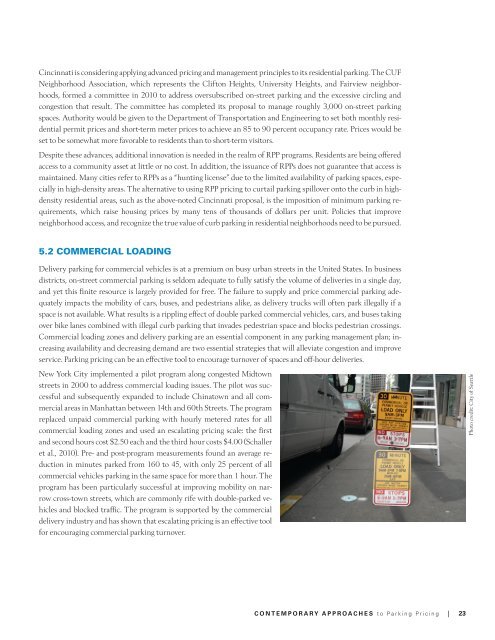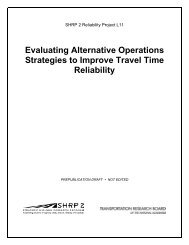Contemporary Approaches to Parking Pricing: - FHWA Operations
Contemporary Approaches to Parking Pricing: - FHWA Operations
Contemporary Approaches to Parking Pricing: - FHWA Operations
Create successful ePaper yourself
Turn your PDF publications into a flip-book with our unique Google optimized e-Paper software.
Cincinnati is considering applying advanced pricing and management principles <strong>to</strong> its residential parking. The CUF<br />
Neighborhood Association, which represents the Clif<strong>to</strong>n Heights, University Heights, and Fairview neighborhoods,<br />
formed a committee in 2010 <strong>to</strong> address oversubscribed on-street parking and the excessive circling and<br />
congestion that result. The committee has completed its proposal <strong>to</strong> manage roughly 3,000 on-street parking<br />
spaces. Authority would be given <strong>to</strong> the Department of Transportation and Engineering <strong>to</strong> set both monthly residential<br />
permit prices and short-term meter prices <strong>to</strong> achieve an 85 <strong>to</strong> 90 percent occupancy rate. Prices would be<br />
set <strong>to</strong> be somewhat more favorable <strong>to</strong> residents than <strong>to</strong> short-term visi<strong>to</strong>rs.<br />
Despite these advances, additional innovation is needed in the realm of RPP programs. Residents are being offered<br />
access <strong>to</strong> a community asset at little or no cost. In addition, the issuance of RPPs does not guarantee that access is<br />
maintained. Many cities refer <strong>to</strong> RPPs as a “hunting license” due <strong>to</strong> the limited availability of parking spaces, especially<br />
in high-density areas. The alternative <strong>to</strong> using RPP pricing <strong>to</strong> curtail parking spillover on<strong>to</strong> the curb in highdensity<br />
residential areas, such as the above-noted Cincinnati proposal, is the imposition of minimum parking requirements,<br />
which raise housing prices by many tens of thousands of dollars per unit. Policies that improve<br />
neighborhood access, and recognize the true value of curb parking in residential neighborhoods need <strong>to</strong> be pursued.<br />
5.2 Commercial Loading<br />
Delivery parking for commercial vehicles is at a premium on busy urban streets in the United States. In business<br />
districts, on-street commercial parking is seldom adequate <strong>to</strong> fully satisfy the volume of deliveries in a single day,<br />
and yet this finite resource is largely provided for free. The failure <strong>to</strong> supply and price commercial parking adequately<br />
impacts the mobility of cars, buses, and pedestrians alike, as delivery trucks will often park illegally if a<br />
space is not available. What results is a rippling effect of double parked commercial vehicles, cars, and buses taking<br />
over bike lanes combined with illegal curb parking that invades pedestrian space and blocks pedestrian crossings.<br />
Commercial loading zones and delivery parking are an essential component in any parking management plan; increasing<br />
availability and decreasing demand are two essential strategies that will alleviate congestion and improve<br />
service. <strong>Parking</strong> pricing can be an effective <strong>to</strong>ol <strong>to</strong> encourage turnover of spaces and off-hour deliveries.<br />
New York City implemented a pilot program along congested Mid<strong>to</strong>wn<br />
streets in 2000 <strong>to</strong> address commercial loading issues. The pilot was successful<br />
and subsequently expanded <strong>to</strong> include China<strong>to</strong>wn and all commercial<br />
areas in Manhattan between 14th and 60th Streets. The program<br />
replaced unpaid commercial parking with hourly metered rates for all<br />
commercial loading zones and used an escalating pricing scale: the first<br />
and second hours cost $2.50 each and the third hour costs $4.00 (Schaller<br />
et al., 2010). Pre- and post-program measurements found an average reduction<br />
in minutes parked from 160 <strong>to</strong> 45, with only 25 percent of all<br />
commercial vehicles parking in the same space for more than 1 hour. The<br />
program has been particularly successful at improving mobility on narrow<br />
cross-<strong>to</strong>wn streets, which are commonly rife with double-parked vehicles<br />
and blocked traffic. The program is supported by the commercial<br />
delivery industry and has shown that escalating pricing is an effective <strong>to</strong>ol<br />
for encouraging commercial parking turnover.<br />
Pho<strong>to</strong> credit: City of Seattle<br />
C o n t e m p o r a r y A p p r o a c h e s t o P a r k i n g P r i c i n g | 23















